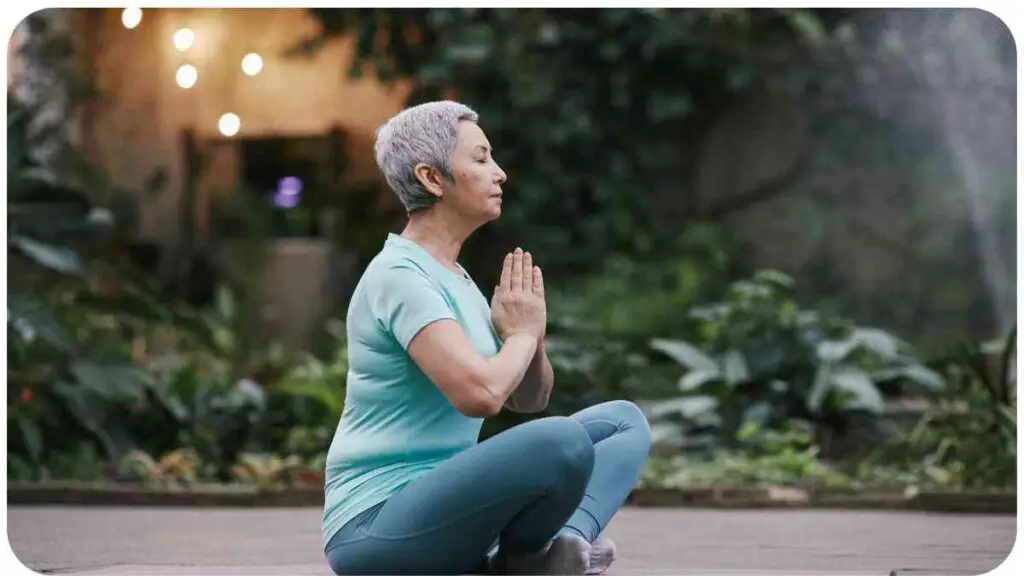Yoga isn’t just about physical postures; it’s a holistic practice that encompasses the mind, body, and spirit. Central to the practice of yoga is the word “Namaste,” which you might have heard in your yoga class or read in yoga literature.
But what does “Namaste” really mean? In this comprehensive guide, we’ll delve into the origins, meanings, cultural significance, and practical applications of Namaste in yoga and beyond.
| Takeaways |
|---|
| Namaste is a gesture of respect and acknowledgment of the divine |
| The word “Namaste” originates from Sanskrit and means “bow to you” |
| Saying Namaste fosters gratitude, mindfulness, and inner peace |
| Namaste can be incorporated into various aspects of daily life |
| Understanding the cultural significance of Namaste enhances its meaning |
| Practicing Namaste promotes connection, humility, and compassion |
2. Origins of Namaste

To truly understand Namaste, we must first explore its roots. The term originates from Sanskrit, an ancient Indo-Aryan language, and is formed by combining two words: “Namaḥ” (नमः), meaning “bow” or “obeisance,” and “te” (ते), meaning “to you.” Together, Namaste can be interpreted as “I bow to you” or “The divine in me bows to the divine in you.”
In the journey of yoga, breath is paramount. Understanding Pranayama, the art of breath control, unlocks profound connections within. Through deliberate inhalations and exhalations, practitioners delve deeper into their practice, aligning mind, body, and spirit.” The Importance of Breath in Yoga: Understanding Pranayama
Table: Origins of Namaste
| Language | Meaning |
|---|---|
| Sanskrit | Bow or Obeisance |
| To You |
3. Meaning of Namaste

The essence of Namaste goes beyond its literal translation. It embodies a profound acknowledgment of the interconnectedness of all beings and the recognition of the divine spark within each individual. When we say Namaste, we’re not just exchanging pleasantries; we’re honoring the divine within ourselves and others.
Table: Meaning of Namaste
| Essence | Interpretation |
|---|---|
| Interconnectedness | Acknowledgment of unity with all beings |
| Divine Recognition | Honoring the divine spark within oneself and others |
4. Cultural Significance
Namaste is deeply ingrained in the cultural and spiritual fabric of India, where it originated. It reflects the ethos of respect, humility, and reverence that are central to Indian philosophy and tradition. Beyond India, Namaste has transcended borders and become a universal symbol of peace and goodwill.
Yoga speaks through mudras, silent gestures that amplify intentions. Understanding these sacred hand positions adds layers of meaning to practice. Each mudra holds a unique resonance, guiding practitioners toward deeper states of awareness and spiritual connection.” What Are Yoga Mudras? Understanding the Basics
Table: Cultural Significance of Namaste
| Culture | Significance |
|---|---|
| Indian | Reflection of respect and humility |
| Global | Universal symbol of peace and goodwill |
Namaste has become synonymous with yoga practice, but its significance extends far beyond the yoga mat. In the next sections, we’ll explore how Namaste is incorporated into various aspects of yoga practice and its broader applications in daily life.
5. Namaste in Yoga Practice
In yoga, Namaste is more than just a salutation; it’s a profound gesture that embodies the essence of the practice. Whether you’re flowing through asanas, meditating, or practicing pranayama, Namaste serves as a reminder of the deeper connection between mind, body, and spirit.
Namaste in Asana Practice
During yoga asana practice, Namaste is often used as a closing gesture to seal the practice. In this context, it signifies gratitude for the practice, reverence for the teachings of yoga, and acknowledgment of the inner journey embarked upon during the practice.
Namaste in Meditation
In meditation, Namaste serves as a mantra, a focal point for the mind, and a reminder of the unity of all beings. By repeating Namaste silently or aloud, practitioners cultivate a sense of peace, presence, and interconnectedness with the universe.
Yoga transcends mere physical exercise; it embodies eight limbs of spiritual growth. Exploring these limbs illuminates the holistic nature of yoga practice. From ethical principles to meditation, each limb offers a pathway toward self-realization and inner harmony.” Understanding the 8 Limbs of Yoga: A Quick Guide
Namaste in Pranayama
In pranayama (breathwork) practice, Namaste is integrated with breath awareness to deepen the connection between breath, body, and consciousness. By synchronizing breath with the utterance of Namaste, practitioners harmonize the flow of prana (life force energy) within the body.
Table: Incorporating Namaste into Yoga Practice
| Yoga Practice | Significance of Namaste |
|---|---|
| Asana Practice | Gratitude, reverence, acknowledgment of inner journey |
| Meditation | Mantra, focal point for the mind, unity with the universe |
| Pranayama | Integration with breath awareness, harmonizing prana flow |
Namaste serves as a unifying thread that weaves through the tapestry of yoga practice, infusing each moment with intention, mindfulness, and grace. But the benefits of Namaste extend beyond the yoga mat. Let’s explore some of the ways in which saying Namaste can positively impact our lives.
6. Benefits of Saying Namaste

The simple act of saying Namaste carries profound benefits for both the speaker and the recipient. Here are some of the key advantages:
- Cultivates Gratitude: Saying Namaste fosters an attitude of gratitude, reminding us to appreciate the blessings and opportunities in our lives.
- Promotes Mindfulness: The mindfulness inherent in the practice of Namaste helps to anchor us in the present moment, fostering clarity, focus, and awareness.
- Fosters Connection: By acknowledging the divinity within ourselves and others, Namaste strengthens our sense of connection and belonging, fostering empathy and compassion.
- Promotes Inner Peace: Saying Namaste invokes a sense of inner peace and harmony, helping to alleviate stress, anxiety, and tension.
- Encourages Humility: The act of bowing in Namaste cultivates humility, reminding us of our interconnectedness and the importance of treating others with respect and kindness.
Empower children with the gift of mindful movement. Integrating yoga and mindfulness into their lives nurtures resilience and emotional intelligence. Through playful asanas and breathing exercises, young yogis cultivate focus, self-awareness, and a lifelong appreciation for holistic well-being.” Yoga and Mindfulness for Kids: What Parents Need to Know
Table: Benefits of Saying Namaste
| Benefit | Description |
|---|---|
| Cultivates Gratitude | Fosters appreciation for blessings and opportunities |
| Promotes Mindfulness | Anchors us in the present moment, fostering clarity and focus |
| Fosters Connection | Strengthens sense of connection and empathy |
| Promotes Inner Peace | Invokes a sense of harmony and alleviates stress and anxiety |
| Encourages Humility | Cultivates humility and respect for others |
Incorporating Namaste into our yoga practice and daily life can have a transformative effect, enriching our experience and deepening our connection with ourselves and others. But how do we say Namaste properly? Let’s explore some guidelines for practicing Namaste with sincerity and authenticity.
7. How to Say Namaste Properly
Saying Namaste is more than just uttering a word; it’s a heartfelt expression of respect and reverence. Here are some tips for saying Namaste with sincerity and authenticity:
- Hands in Prayer Position: Bring your palms together at the heart center, fingers pointing upward, in the Anjali Mudra (prayer position).
- Bow Slightly: Bow your head slightly toward your hands as you say “Namaste,” acknowledging the divine within yourself and the other person.
- Synchronize Breath: If practicing Namaste in a yoga class, synchronize the utterance of Namaste with the breath, exhaling as you bow and say “Namaste.”
- Eye Contact: Maintain gentle eye contact with the person or group you are addressing, conveying sincerity and presence.
Table: Guidelines for Saying Namaste
| Step | Description |
|---|---|
| Hands in Prayer Position | Bring palms together at heart center, fingers pointing upward |
| Bow Slightly | Bow head toward hands as you say “Namaste” |
| Synchronize Breath | Exhale as you bow and say “Namaste,” syncing with the breath |
| Eye Contact | Maintain gentle eye contact to convey sincerity and presence |
By following these guidelines, we can ensure that our expression of Namaste is genuine, respectful, and imbued with the spirit of yoga. But how does Namaste vary across different cultures and contexts? Let’s explore this in the next section.
8. Namaste in Different Cultures
While Namaste originated in India as a traditional greeting and salutation, its popularity has spread far beyond its country of origin. In different cultures and contexts, variations of Namaste exist, each carrying its own unique nuances and meanings.
Mantras resonate as vibrational keys to mindfulness. Delve into their power to enrich meditation and daily life. Through chanting and contemplation, mantras infuse each moment with intention, fostering inner peace and spiritual alignment.” The Role of Mantras in Mindfulness: Understanding the Basics
Table: Variations of Namaste Across Cultures
| Culture | Variation | Meaning |
|---|---|---|
| India | Namaste | Bowing to the divine within oneself and others |
| Nepal | Namaskar | Same as Namaste, commonly used in Nepal |
| Thailand | Sawasdee | Greeting meaning “hello” or “goodbye” |
| Japan | Gassho | Gesture of placing hands together in prayer |
| Tibet | Tashi Delek | Greeting meaning “blessings and good luck” |
Despite the cultural variations in expression, the underlying sentiment of respect, humility, and acknowledgment of the divine remains consistent across different interpretations of Namaste.
9. Common Misconceptions
Despite its widespread use, Namaste is sometimes misunderstood or misinterpreted. Let’s address some common misconceptions surrounding Namaste:
- Religious Affiliation: While Namaste has roots in Hinduism, it is a universal expression of respect and reverence, transcending religious boundaries.
- Cultural Appropriation: When used sincerely and respectfully, Namaste can foster cross-cultural understanding and appreciation rather than appropriation.
- Solely a Yoga Term: While Namaste is commonly associated with yoga, its applications extend beyond the yoga studio and into daily life as a symbol of peace and goodwill.
By dispelling these misconceptions, we can foster a deeper understanding and appreciation of the true essence of Namaste.
10. Namaste Beyond Yoga
Namaste isn’t confined to the walls of a yoga studio; it’s a philosophy that can be applied to all aspects of life. Whether we’re greeting a friend, expressing gratitude, or showing respect to a colleague, the spirit of Namaste can guide our interactions and enrich our relationships.
Table: Applications of Namaste Beyond Yoga
| Context | Application |
|---|---|
| Everyday Greeting | Expressing respect and goodwill in daily interactions |
| Gratitude | Acknowledging blessings and expressing appreciation for the people and experiences in our lives |
| Conflict Resolution | Fostering empathy, understanding, and reconciliation in times of conflict |
| Community Building | Strengthening connections and building unity within communities and organizations |
By incorporating the principles of Namaste into our interactions, we can create a more harmonious and compassionate world.
11. Incorporating Namaste into Daily Life
Now that we understand the depth and significance of Namaste, how can we incorporate this practice into our daily lives? Here are some practical ways to infuse the spirit of Namaste into our interactions and experiences:
- Morning Ritual: Begin your day with a simple Namaste meditation, closing your eyes, bringing your hands to prayer position, and silently repeating “Namaste” as a mantra to set the tone for the day ahead.
- Greeting Others: Whether it’s a friend, family member, or stranger, greet others with a heartfelt Namaste, acknowledging the divine within them and fostering a sense of connection and respect.
- Expressing Gratitude: Take a moment each day to reflect on the blessings in your life and express gratitude with a sincere Namaste, recognizing the abundance and beauty that surrounds you.
- Conflict Resolution: In moments of conflict or disagreement, pause, take a breath, and offer a genuine Namaste as a gesture of respect and willingness to find common ground.
- Community Service: Engage in acts of service and volunteerism with a spirit of Namaste, recognizing the interconnectedness of all beings and the importance of contributing to the well-being of others.
Table: Practical Ways to Incorporate Namaste into Daily Life
| Practice | Description |
|---|---|
| Morning Ritual | Start the day with a Namaste meditation to set the tone for the day ahead |
| Greeting Others | Offer a heartfelt Namaste as a greeting to foster connection and respect |
| Expressing Gratitude | Reflect on blessings and express gratitude with a sincere Namaste |
| Conflict Resolution | Pause, offer a Namaste, and approach conflicts with respect and willingness to find common ground |
| Community Service | Engage in acts of service with a spirit of Namaste, recognizing the interconnectedness of all beings |
By infusing our daily lives with the spirit of Namaste, we can cultivate a greater sense of peace, harmony, and connection with ourselves, others, and the world around us.
12. Conclusion
In conclusion, Namaste is more than just a word; it’s a profound expression of respect, humility, and acknowledgment of the divine within ourselves and others. Whether practiced on the yoga mat, in daily interactions, or in moments of reflection, Namaste serves as a powerful reminder of our interconnectedness and the universal principles of love, compassion, and unity.
By embracing the spirit of Namaste, we can cultivate deeper connections, foster greater understanding, and create a more harmonious and compassionate world for all.
Further Reading
- The Meaning of Namaste – Yoga Journal
- Explore the profound significance of Namaste in yoga practice and its cultural roots.
- Understanding Namaste: The Meaning and Significance – Yoga Basics
- Delve into the deeper meanings and cultural contexts of Namaste in yoga and beyond.
- Unlocking the Power of Namaste – MindBodyGreen
- Learn how to unlock the transformative power of Namaste in your yoga practice and daily life.
FAQs
What is the significance of saying Namaste?
Saying Namaste is a gesture of respect, humility, and acknowledgment of the divine within oneself and others.
Can I use Namaste in everyday interactions?
Yes, you can use Namaste as a greeting or expression of gratitude in everyday interactions to foster connection and respect.
How do I say Namaste properly?
To say Namaste properly, bring your hands to the prayer position at the heart center, bow your head slightly, and say “Namaste” with sincerity and presence.
Is Namaste only used in yoga?
While Namaste is commonly associated with yoga, its applications extend beyond the yoga studio into various cultural and social contexts.
Where can I learn more about the meaning of Namaste?
You can explore further resources such as articles, books, and online forums to deepen your understanding of the meaning and significance of Namaste.

Hello, my name is Hellen James! I am a yoga teacher and writer who loves to share information about how you can achieve a more fulfilling life. I have been practicing mindfulness, yoga, and meditation for over 10 years. My passion for these practices has led me to teach them to others.

